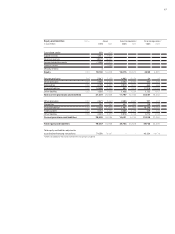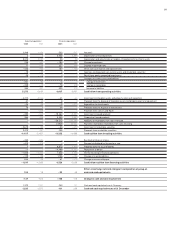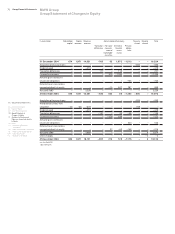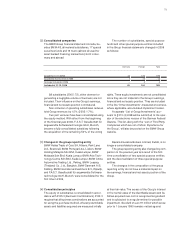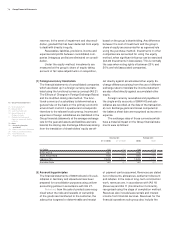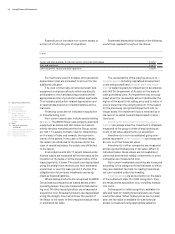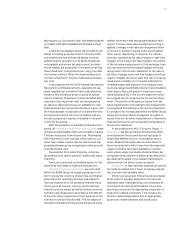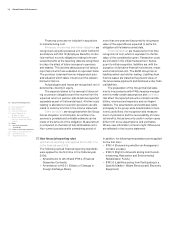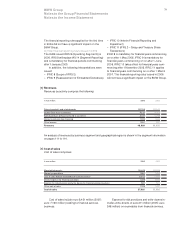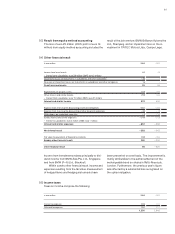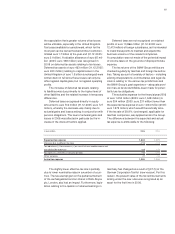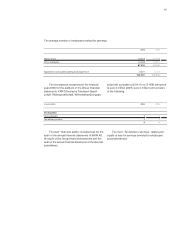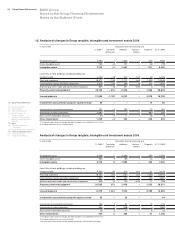BMW 2006 Annual Report Download - page 77
Download and view the complete annual report
Please find page 77 of the 2006 BMW annual report below. You can navigate through the pages in the report by either clicking on the pages listed below, or by using the keyword search tool below to find specific information within the annual report.
Expenditure on low value non-current assets is
written off in full in the year of acquisition.
Systematic depreciation is based on the following
useful lives, applied throughout the Group:
For machinery used in multiple-shift operations,
depreciation rates are increased to account for the
additional utilisation.
The cost of internally constructed plant and
equipment comprises all costs which are directly
attributable to the manufacturing process and an
appropriate portion of production-related overheads.
This includes production-related depreciation and
an appropriate proportion of administrative and so-
cial costs.
Financing costs are not included in acquisition
or manufacturing cost.
Non-current assets also include assets relating
to leases. The BMW Group uses property, plant and
equipment as lessee and also leases out assets,
mainly vehicles manufactured by the Group, as les-
sor. IAS 17 (Leases) contains rules for determining,
on the basis of risks and rewards, the economic
owner of the assets. In the case of finance leases
the assets are attributed to the lessee and in the
case of operating leases the assets are attributed
to
the lessor.
In accordance with IAS 17, assets leased under
finance leases are measured at their fair value at the
inception of the lease or at the present value of the
lease payments, if lower. The assets are depreciated
using the straight-line method over their estimated
useful lives or over the lease period, if shorter. The
obligations for future lease instalments are recog-
nised
as financial liabilities.
Where Group products are recognised by BMW
Group leasing companies as leased assets under
operating leases, they are measured at manufactur-
ing cost. All other leased products are measured at
acquisition cost. All leased products are depreciated
using the straight-line method over the period of
the
lease to the lower of their imputed residual value
or estimated fair value.
The recoverability of the carrying amount of in-
tangible assets (including capitalised development
costs and goodwill) and property, plant and
equip-
ment is tested regularly for impairment in accordance
with IAS 36 (Impairment of Assets) on the basis of
cash generating units. An impairment loss is recog-
nised when the recoverable amount (defined as the
higher of the asset’s net selling price and its value in
use) is lower than the carrying amount. If the reason
for the previously recognised impairment loss no
longer exists, the impairment loss is reversed up to
the level of its rolled-forward depreciated or amor-
tised cost.
Investments accounted for using the equity
method are (except when the investment is impaired)
measured at the group’s share of equity taking ac-
count of fair value adjustments on acquisition.
Investments in non-consolidated group com-
panies reported in other investments are measured
at cost, or at their lower fair value.
Investments in other companies are measured
at their quoted market price or fair value. When, in
individual cases, these values are not available or
cannot be determined reliably, investments in other
companies are measured at cost.
Non-current marketable securities are measured
according to the category of financial asset to which
they are classified. No held-for-trading financial as-
sets are included under this heading.
Financial assets are accounted for on the basis
of the settlement date. On initial recognition, they
are measured at acquisition cost, including transac-
tion costs.
Subsequent to initial recognition, available-for-
sale and held-for-trading financial assets are meas-
ured at fair value. When market prices are not avail-
able, the fair value of available-for-sale financial
assets is measured using appropriate valuation
76 Group Financial Statements
65 Group Financial Statements
65 Income Statements
66 Balance Sheets
68 Cash Flow Statements
70 Group Statement of
Changes in Equity
71 Statement of Income and
Expenses recognised directly
in Equity
72 Notes
72 – Accounting Principles
and Policies
79 – Notes to the Income Statement
86 – Notes to the Balance Sheet
104 – Other Disclosures
111 – Segment Information
in years
Factory and office buildings, distribution facilities and residential buildings 8 to 50
Plant and machinery 5 to 10
Other equipment, factory and office equipment 3 to 10



